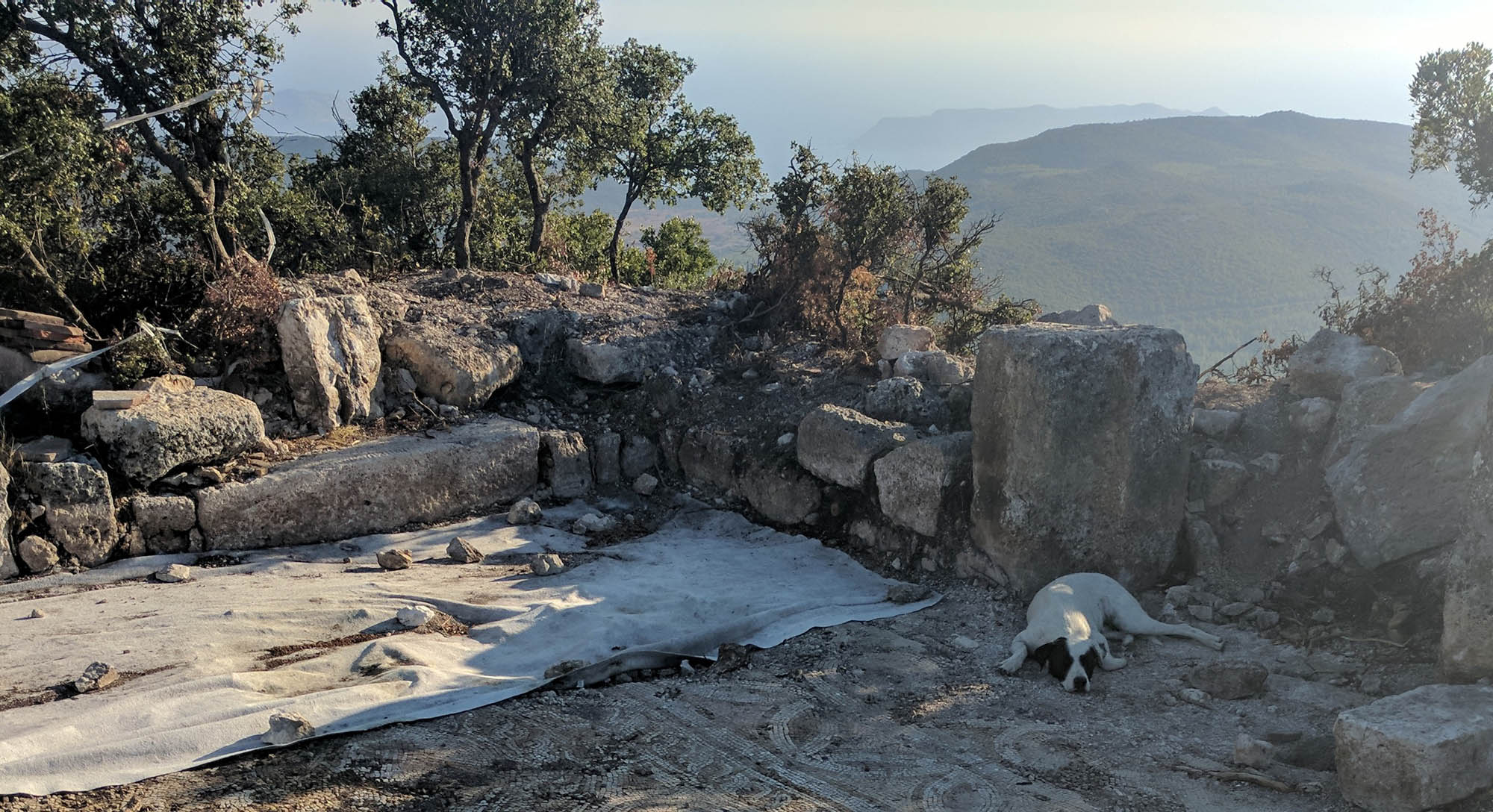
This Story is by a fellow hiker, Ronald who trekked the Lycian way in September 2017
It was early September in Antalya when I shook the bell on the gate to the courtyard of the Culture Routes Society. Kate poked her head out, and I said I was passing through to hike the Lycian Way and wondered if I might leave behind my luggage. She let me inside and told me I could put my things in the hall closet and then introduced me to Nastya, their translator, and Hü, the societies manager. As I left to bring back my bags from the hotel Hü invited me to lunch with them. We went down the street to a corner place, a small diner called Can Can. It was here, while talking about the trail, Kate suggested in the politest terms that I temper my expectations. Not by lowering, but broadening them. Much of my hiking experience until now had been along back country trails in America; long stretches of remote wilderness sparsely settled with few, if any, people along the way.
I left Antalya by bus to Fethiye and arrived shortly after noon. I had never seen a bus with cart service before. First class bus accommodation provides a rather comfortable means of touring Turkey. Fethiye is another large tourist town. The kind that dots the coast of Turkey and any other stretch of subtropical sea. It’s saving interest is the large tombs carved into the cliff that look over the city. I started late out of Fethiye and hit the head of the trail outside Ovacik around 13:00. I climbed around Baba Dağ, along the sea, beneath the untempered sun and distant screams of parasailers high above, hung beneath brightly colored chutes gently floating down to the beach of Ölüdeniz below. I took shade under a boulder, where I could find it, as I climbed hundreds of meters up over brown-gray rock and dust. The last rain was months ago and the cooler fall season would not arrive for weeks.
As every hiker who’s put enough miles beneath their boots has often wondered, I asked myself why I was here. I answered this question with a look over my shoulder. Behind me was an unobstructed view of mountains that had been carved from the earth, a mix of smooth gray rock and soft green trees, and a valley folded between far peaks into an open-mouthed harbor with sandy cheeks spilling into the still waters of the Mediterranean where the white sun carved a path from the shore to the horizon. And so, I moved on. Only the sun followed me over the ridge and down into the tiny beekeeping village of Kirme. From here I would walk past several fields of bee boxes set on cliffs overlooking the coast with tiny white-suited workers buzzing between the hives. I stumbled into Faralya for the evening and rested on a bench at Georges watching the sun set on Butterfly valley 500 meters below. My pack was too heavy, outfitted for a longer back country trek, and I had quickly moved through my four liters of water that day arriving salted with sweat, dehydrated and drained of all energy.
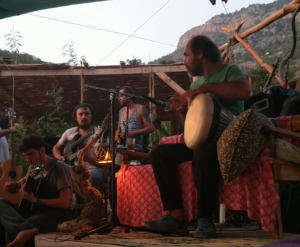 The next morning I left Faralya and arrived in Kabak in under two hours. I stopped in one of the older camps for a cold drink and to rest in the shade. Kabak is an interesting place mixing a hippie commune-like lifestyle with a robust commercialization. As I was chatting at the bar preparing to leave I was told that I had arrived on the first day of a music festival, the Müzik & Sanat Buluşmalari. So, I spent the weekend there at one of the older camps; Reflections, I believe. The foot end of the bed, draped in a bug net, inside a shaky looking three-walled lean-to opened into the trees facing the beach below. I had a cat for a roommate who was fond of sleeping on my dirty clothes and would wake me by sitting on my head every morning. In the evening I saw a man walking down a path with a guitar over his shoulder so I stopped and spoke with him. His name was Eren, from Istanbul, and he was on his way to deliver a bass to his friends who were playing a show with Misirli Ahmet. He invited me to join him. I can best describe their sound as Turkish improvisational Jazz – a Darbouka with a bass and a double neck electric guitar.
The next morning I left Faralya and arrived in Kabak in under two hours. I stopped in one of the older camps for a cold drink and to rest in the shade. Kabak is an interesting place mixing a hippie commune-like lifestyle with a robust commercialization. As I was chatting at the bar preparing to leave I was told that I had arrived on the first day of a music festival, the Müzik & Sanat Buluşmalari. So, I spent the weekend there at one of the older camps; Reflections, I believe. The foot end of the bed, draped in a bug net, inside a shaky looking three-walled lean-to opened into the trees facing the beach below. I had a cat for a roommate who was fond of sleeping on my dirty clothes and would wake me by sitting on my head every morning. In the evening I saw a man walking down a path with a guitar over his shoulder so I stopped and spoke with him. His name was Eren, from Istanbul, and he was on his way to deliver a bass to his friends who were playing a show with Misirli Ahmet. He invited me to join him. I can best describe their sound as Turkish improvisational Jazz – a Darbouka with a bass and a double neck electric guitar. 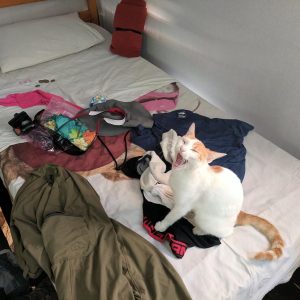 Other players switched in and out with drums, symbols, and vocals. Ahmet led the band with the Darbouka and would stop between songs to tell a story, introduce new players, or explain his instrument and what he was doing. After a while he asked if anyone had any questions about his show and a small boy asked why he talked so much drawing a laugh from the crowd. The deck we were on was set up in the trees peeking out from the side of the mountain to overlook the beach below. The band played as the light of the sun gave way to the flickering lamps on the stage and the glow of his drum. After the show Eren invited me to have dinner with him and his friends. It was a large meal of many different vegetable dishes, soup, and bread. We sat around drinking tea for a while and later headed to the Tree House to see a pop band called Flört. At some point Eren and I were separated and I never saw him again after that. I would have liked to say goodbye, or at least thank you, but it is often the plight of the traveler to see many people come and go and never see them again. I remembered sitting in that café back in Antalya explaining my plan of approach and my expected pace. I was told the sections had been plotted out purposefully in short portions, especially in that first western section, because there was so much to come by beyond simple forest and trail. Tempered expectations, indeed.
Other players switched in and out with drums, symbols, and vocals. Ahmet led the band with the Darbouka and would stop between songs to tell a story, introduce new players, or explain his instrument and what he was doing. After a while he asked if anyone had any questions about his show and a small boy asked why he talked so much drawing a laugh from the crowd. The deck we were on was set up in the trees peeking out from the side of the mountain to overlook the beach below. The band played as the light of the sun gave way to the flickering lamps on the stage and the glow of his drum. After the show Eren invited me to have dinner with him and his friends. It was a large meal of many different vegetable dishes, soup, and bread. We sat around drinking tea for a while and later headed to the Tree House to see a pop band called Flört. At some point Eren and I were separated and I never saw him again after that. I would have liked to say goodbye, or at least thank you, but it is often the plight of the traveler to see many people come and go and never see them again. I remembered sitting in that café back in Antalya explaining my plan of approach and my expected pace. I was told the sections had been plotted out purposefully in short portions, especially in that first western section, because there was so much to come by beyond simple forest and trail. Tempered expectations, indeed.
I left Kabak early and, rather than go inland, followed a coastal trail that bypassed Alinca. I got lost several times, but easily found the path again with a little help from my GPS and a bit of bushwhacking uphill. The views up and down the coast were worth the detour. The tapered spines of the mountains jutted like fingers reaching into the sea as tiny vessels ambled around them tracing out the shoreline. I rejoined the main trail past Alinca near a well. Since leaving Kabak I had once again depleted my water. I had to climb down through the broken concrete top of the well and crawl into the cavern to reach the trickle of water in the back, thankful for its cool flow. As I filled my bottles, goats standing 15 meters above bleated and kicked rocks down at me. I hid behind a protrusion of concrete as I filtered the water and rocks tumbled over my shoulder. I moved quickly from there and set up for the night further down the trail on an old threshing floor on the edge of a cliff near a shepherds camp. As I sat under the holly oak tree in the dark eating my supper I heard the namaz drifting somewhere out of the valleys around me. It’s a comforting thing sometimes to know you’re not alone in the dark even when other people are unknowingly far away. I wondered about the shepherds who lived here. Would they have pulled out their mats and faced toward Mecca? Would they too have sat in the darkness beneath the holly tree and looked out over the valley as the night mists dragged over the mountains and into the sea?
I set out in the morning for Sidyma, once again losing the trail along the way, but the map made it simple to navigate. Just skirt the base of the mountain along the edge of the forest through terraced olive groves until you cross the trail to Dodurga just below Boğazıçı. Once again, I ran out of water and every spring along the way was dry. I crawled into Dodurga and stopped at the town çeşme where just a trickle was falling out hovered over by hornets and bees all looking for some water in the sun soaked heat. As I was drinking from the fountain a man from the village approached to gather water for his home. His name was Jamid. We spoke briefly with a mixed vocabulary of English and Turkish words. He invited me to his house for tea and something to eat. He asked me why I was hiking, and I tried to explain that I liked the exercise, but we each lacked this word in our respective vocabularies. Frustrated, and wanting to finish my thought, I leaned back and slapped my belly. I’m not sure why I thought this would be effective. Jamid laughed and reached over to pat my stomach and then leaned back and slapped his own, and laughed again. I suppose I got my point across.
I made my way from Dodurga beneath Sidyma to Bel. A portion of the trail was blocked off, perhaps by farmers not wanting hikers to cross their fence, so I followed the paved road. As I entered Bel I stopped at a house still in the midst of construction where a woman lived who served food to passing travelers. It was like an old-style inn with beds on the second floor for guests to stay the night and the menu choices for food are yes and no. Everything she prepared was fresh from her garden. There was soup, bread, a dish of lentils, salad, cola and water, followed by a large plate of fruit, and of course çay. It is often self-ingratiating to recall the circumstances when you learned a particular word in another language. As I sat down to take off my shoes she kept speaking in Turkish and motioning to the side of the building. I heard her say “su” several times, but it didn’t seem like she was offering me something to drink. Eventually I picked out the word douche, but more so in the French way. I must have smelled horrid after spending so many days drenched in sweat and going to concerts that she was keen on showing me where the shower was. When I turned the corner there was a sign on the wall that said duş and that was when I realized the words were the same, one of the many French words that began their migration to Turkish over a century ago. I would come to learn there are a lot of words like this scattered about the language leaving sign posts of familiarity for the more accustomed Latins speaker.
 I left Bel and started winding above the valley and back towards the sea. Along the way I passed a somber old woman sitting on the edge of the road next to her scooter, her feet dangling off the edge of the roadside, watching the large machinery far off in the valley slowly chipping away at the mountain exposing the rock beneath, white as bone. As I passed, she looked up and smiled with cracked cheeks and bright eyes and offered me some berries she had picked from the sack beside her. I wonder if she was reminiscing of a time when her wilderness had been unmarred by the tell-tale rumble and smoke of that engine called progress. I moved on and made my way around the mountain down a steep rocky path towards Gavurağılı. While descending I saw the silhouette of a patrol boat slowly heading south along the shore. Crossing some more fields and passing into a small abandoned town, I camped beneath a windswept tree on a cliff over a small beach that was sadly littered with trash. It seemed frequented by weekend visitors. I sat overlooking the water, hearing the cry of waves upon the shore 20 meters beneath me while the sun stripped its yellow skin and dipped its bare orange hue into the Mediterranean as the patrol boat plotted its return up the coast. The vessels outline faded with the darkening sky into two lights floating out in the night, one red and one green, drifting east, possibly searching for refugees crashing upon the Turkish shore like the waves lapping against the rocks below.
I left Bel and started winding above the valley and back towards the sea. Along the way I passed a somber old woman sitting on the edge of the road next to her scooter, her feet dangling off the edge of the roadside, watching the large machinery far off in the valley slowly chipping away at the mountain exposing the rock beneath, white as bone. As I passed, she looked up and smiled with cracked cheeks and bright eyes and offered me some berries she had picked from the sack beside her. I wonder if she was reminiscing of a time when her wilderness had been unmarred by the tell-tale rumble and smoke of that engine called progress. I moved on and made my way around the mountain down a steep rocky path towards Gavurağılı. While descending I saw the silhouette of a patrol boat slowly heading south along the shore. Crossing some more fields and passing into a small abandoned town, I camped beneath a windswept tree on a cliff over a small beach that was sadly littered with trash. It seemed frequented by weekend visitors. I sat overlooking the water, hearing the cry of waves upon the shore 20 meters beneath me while the sun stripped its yellow skin and dipped its bare orange hue into the Mediterranean as the patrol boat plotted its return up the coast. The vessels outline faded with the darkening sky into two lights floating out in the night, one red and one green, drifting east, possibly searching for refugees crashing upon the Turkish shore like the waves lapping against the rocks below.
I woke and broke camp quickly, heading for Pydnai. I lost my way several times, but knew to follow the ridge above and eventually I returned to the track. When I crossed the ridge, I doubled back along the top and was rewarded with a wide open view of the valley beneath me opening up to the coast where Gavurağılı stands. After descending I entered the back gate of Pydnai and was greeted by graffitti marring the stones of this ancient fortress. It is unfortunate that in every part of the world I’ve traveled children feel the need to wander into the wilderness and amuse themselves by scarring the heritage of a region. It is good then, I suppose, that they do not wander far. Passing through the ruins of Pydnai, I finally descended to the beach of Patara stretching several kilometers along the coast. After crossing a rickety bridge with small boats beached along the banks of the river, there is a restaurant at the edge of the sand. I sat here to charge my phone and have lunch, hoping they had Turkish pancakes. Like the difference between American and British chips or biscuits, Gözleme is very unlike what I had imagined. When I first heard of it, it was advertised as pancakes with cheese, pancakes with mixed vegetables, pancakes with potatoes, and so on. It is not something that sounded appetizing to my ear. I first had gözleme leaving Kabak, more by accident than intent. Imagine my surprise when what came out was familiar to me as perhaps the most delicious quesadilla I had ever had, a dish found in Mexico and much of the United States. It was a thin dough rolled out on a chopping block filled with ground beef and cheese folded over and perfectly crisped with oil on a slightly curved grill set over a fire. Later in Kalkan I had Şam böreği, which I was told was from western Turkey. It is incredibly similar to fried boudin balls common in southern Louisiana in the United States.
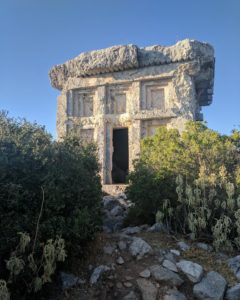 Patara was a massive set of ruins stretching over an area far larger than what was set out by park signage. If you wander off the trails away from the massive Amphitheatre and council hall, you can see the ruins of old churches and ancient structures, once lost in the sands of Patara some 500 years ago, now hidden in the overgrown, thorny scrub and brush of modern times. Xanthos was impressive from its vantage point easily overlooking the valley sliced down the middle by the Esen Çay. Once as green as the river, now it was white with the rooves of greenhouses spread across the entire valley floor. Not far from here was Letoon, a site most notable for its mosaic in the temple of Apollo and sacred spring. Some new construction is under way here developing a modern parking area and visitors center. I spent a few days in Kalkan where I rented a scooter and rode it to Xathos and Kinik, and all around the mountains. I arrived back in Kinik on market day. The tents spilled over a huge area like a canopy of canvas covering a mass of people crawling around tables bartering over fresh fruits, nuts, spices, farm-churned butter and yoghurts, clothes, toys, household goods, and a thousand other things. From here I traveled further inland to Saklikent National Park. I saw the waterfall and walked into the gorge. I rode through farmland and visited towns not along the trail. I stopped at a small roadside restaurant and was feeling confident enough to make my order entirely in Turkish. I asked for a coke and a pide with two different toppings. About twenty minutes later the waitress brought me a coke and two pides, each with one topping. I suppose that’s close enough on the test to still be considered passing. Kalkan itself was filled with British expats. So many, there wasn’t very much of Turkey left in it. Not like its neighboring towns. Prices on the signs were in Pounds as well as Lira and all of the restaurants gave a choice between a Turkish and an English breakfast. It was designed to cater to the Brit holiday. Nice I suppose for sitting on the beach and sipping a cocktail, but not for exploring new things.
Patara was a massive set of ruins stretching over an area far larger than what was set out by park signage. If you wander off the trails away from the massive Amphitheatre and council hall, you can see the ruins of old churches and ancient structures, once lost in the sands of Patara some 500 years ago, now hidden in the overgrown, thorny scrub and brush of modern times. Xanthos was impressive from its vantage point easily overlooking the valley sliced down the middle by the Esen Çay. Once as green as the river, now it was white with the rooves of greenhouses spread across the entire valley floor. Not far from here was Letoon, a site most notable for its mosaic in the temple of Apollo and sacred spring. Some new construction is under way here developing a modern parking area and visitors center. I spent a few days in Kalkan where I rented a scooter and rode it to Xathos and Kinik, and all around the mountains. I arrived back in Kinik on market day. The tents spilled over a huge area like a canopy of canvas covering a mass of people crawling around tables bartering over fresh fruits, nuts, spices, farm-churned butter and yoghurts, clothes, toys, household goods, and a thousand other things. From here I traveled further inland to Saklikent National Park. I saw the waterfall and walked into the gorge. I rode through farmland and visited towns not along the trail. I stopped at a small roadside restaurant and was feeling confident enough to make my order entirely in Turkish. I asked for a coke and a pide with two different toppings. About twenty minutes later the waitress brought me a coke and two pides, each with one topping. I suppose that’s close enough on the test to still be considered passing. Kalkan itself was filled with British expats. So many, there wasn’t very much of Turkey left in it. Not like its neighboring towns. Prices on the signs were in Pounds as well as Lira and all of the restaurants gave a choice between a Turkish and an English breakfast. It was designed to cater to the Brit holiday. Nice I suppose for sitting on the beach and sipping a cocktail, but not for exploring new things.
Leaving Kalkan later in the evening I climbed the old Roman path to the summer fields in the ova of Bezirgan, arriving at the edge of the town near the grain ambars as the crescent moon began to glow over the mountain. In the dark I missed the path to the pansiyon and made my way across the entire ova passing a field with piled stalks and a fire burning in the distance eventually arriving at a small store near the second mosque. There was a group of old men sitting at a table in front of the store under the single fluorescent light beneath the eave amidst the hum of coca-cola coolers. I asked where I might find accommodation, but could not understand them. Eventually one of the men called the pansiyon for directions. The man who answered had a thick Turkish accent and I couldn’t follow what he was saying over the phone. He said he would put his wife Pauline on because she was from the UK. Unfortunately she was Scottish, so I couldn’t quite pick my way through her accent over the phone either. One of the old men put me on the back of his scooter. We went bumping across the quiet town, the tiny bobbing beam of light yanking trees and houses from the darkness and then tossing them back into it again as we whizzed down dirt rut roads cut between homes and fields. Pauline met me at the gate of her house and showed me to a comfortable room at the back of their property. It was out of season and I was the first guest they had had in some time. In the morning she prepared a delicious breakfast in her garden where we sat and chatted. We had such a nice conversation I didn’t leave their house until nearly after noon. I stuck around long enough for her husband to buy me some bread from the bread man as he passed by in his truck.
 I set out from Bezirgan and crossed the pass into Saribelen. I made my way along the edge of the town where an old man on a motorcycle saw me walking up the road and he stopped to offer me a ride up the hill. I hopped on the back and he dropped me off at the bend where the trail leaves into the mountains. He kept trying to say something to me that I didn’t quite understand at the time. Eventually, realizing we were not communicating we smiled at each other and said our goodbyes. I climbed up a wide evenly graded trail over the mountain and down into pasture. It was a long stretch of farmland high up in the mountains with views just peaking down the coast to Kaş. It took a while to pass through the groves and fields. I went past an old lady working in front of a hut who offered me some çay. She asked where I was headed and I said towards Gökçöeren. I moved on and continued across more fields. Along the way I passed a man travelling in the opposite direction as me down the trail. His name was Hüseyin and he was the owner of all this land. We spoke for a minute before I realized this was the same man who had given me a ride on the back of his motorcycle. He had been pointing ahead to his farm, which I was set to cross a few hours after he dropped me off. It was beginning to get dark, so I pressed on past the old man’s house and the ruins scattered about his property until I reached some terraced fields that overlooked Gökçöeren. It was here that I set up camp for the night. It was quiet and cold as I sat against a rock eating over-salted, rehydrated noodles. The scorching temperatures of early September had finally started to wane enough that there was a chill. I had always been surprised at the paucity of dangerous wildlife to be found along this trail since I first began. No bears or coyotes, no wolves, no poison ivy or poison oak, and only one species of venomous snake, the Ottoman Viper, which I had thankfully not come across. I also saw no dear or any animal other than goats , village dogs, a few turtles, and the occasional squirrel. This region has been continually inhabited since prehistoric times. Several great civilizations have risen and fallen upon these mountains by the sea. All of these creatures we might associate with untamed wilderness were likely driven out long ago. There is little left to be wild when so much has been written and rewritten.
I set out from Bezirgan and crossed the pass into Saribelen. I made my way along the edge of the town where an old man on a motorcycle saw me walking up the road and he stopped to offer me a ride up the hill. I hopped on the back and he dropped me off at the bend where the trail leaves into the mountains. He kept trying to say something to me that I didn’t quite understand at the time. Eventually, realizing we were not communicating we smiled at each other and said our goodbyes. I climbed up a wide evenly graded trail over the mountain and down into pasture. It was a long stretch of farmland high up in the mountains with views just peaking down the coast to Kaş. It took a while to pass through the groves and fields. I went past an old lady working in front of a hut who offered me some çay. She asked where I was headed and I said towards Gökçöeren. I moved on and continued across more fields. Along the way I passed a man travelling in the opposite direction as me down the trail. His name was Hüseyin and he was the owner of all this land. We spoke for a minute before I realized this was the same man who had given me a ride on the back of his motorcycle. He had been pointing ahead to his farm, which I was set to cross a few hours after he dropped me off. It was beginning to get dark, so I pressed on past the old man’s house and the ruins scattered about his property until I reached some terraced fields that overlooked Gökçöeren. It was here that I set up camp for the night. It was quiet and cold as I sat against a rock eating over-salted, rehydrated noodles. The scorching temperatures of early September had finally started to wane enough that there was a chill. I had always been surprised at the paucity of dangerous wildlife to be found along this trail since I first began. No bears or coyotes, no wolves, no poison ivy or poison oak, and only one species of venomous snake, the Ottoman Viper, which I had thankfully not come across. I also saw no dear or any animal other than goats , village dogs, a few turtles, and the occasional squirrel. This region has been continually inhabited since prehistoric times. Several great civilizations have risen and fallen upon these mountains by the sea. All of these creatures we might associate with untamed wilderness were likely driven out long ago. There is little left to be wild when so much has been written and rewritten.
The night was colder than I had anticipated, but warmed quickly when morning broke. As I rolled up my sleeping bag and packed my gear a shepherd moved his flock through my campsite whistling as he passed and the sun stretched out over the ova of the valley of Gökçöeren. It was a short walk into town where I sat outside the village fountain next to the mosque and refilled my water for the climb to Phellos. It had become a maxim that was of great utility throughout my trip – where there is a mosque, there is always water. As I sat drinking I was accompanied by a tagged dog who couldn’t decide if he wanted to lay at my feet or chase cars. Dogs with tagged ears are very common in the cities and villages of Turkey. They’re captured, vaccinated, and in many cases neutered, then tagged and released back into the streets. Many of these dogs are adopted by tourists who take kindly to them. As I left Gökçöeren my new friend followed me all the way to the trail junction 8 kilometres outside of town. He continued to follow me up the mountain to Phellos and on into Çukurbağ, a distance totaling 22 kilometres and nearly 2 kilometres of elevation change. I would be lost several times, but my trail companion seemed to know the way. He would always run ahead as we neared a water source.
 As I marked the halfway point to the summit I met another hiker headed in the opposite direction. Her name was Mariana, from Belarus. Like most of my encounters in this region our conversation was a mixture of words from several languages as we each struggled to convey the thoughts we wanted to with what little common language we possessed. She had just come from Phellos and said the trail ahead was beautiful but thick with thorns. She was the first hiker I had come across in my time on the trail. She asked if I wanted to take a selfie. She gave me her card to send her the image of our trail meeting, but I lost it somewhere on the way to Pinarbaşi and never did get to contact her again. I would meander off the trail several times on the way to the summit often finding myself going in circles and at one point having to climb 20 meters up steep rock thick with trees to find the trail again. In early evening I reached Phellos. Entering the site there is a Roman mosaic, partially reconstructed as part of an active dig, open to the elements within the confines of a flattened structure and only partly covered by a canvas. There are tombs littered around the site and an inscribed pillar toppled across the trail. Phellos is little visited and overgrown because of the difficulty in reaching it from any nearby roads making it almost ideal for its lack of exploitation, but at the same time it is at the mercy of those who come to enjoy it. Perhaps the visitors to Phellos can preserve it today as it has been preserved for the last two millennia. Leaving Phellos I descended into Pinarbaşi and stopped for water at the mosque where the trail meets the road. Following the road from here I went on to Çukurbağ and made Kaş shortly after nightfall. The beach town of Kaş at the ancient harbor of Antiphellos on the coast just across from the Greek island of Meis is one of the few large tourists towns along this section of the Mediterranean that still feels Turkish. It lacks much of the kinds of international commercialization that can over-commodify a place like the British pervasion of Kalkan and the McDonalds and malls one might find in Fethiye. Lamenting my obligations to the outside world, I stayed in Kaş for a day and then took a dolmuş along the coast back to Antalya to pick up my luggage from the Culture Routes Society.
As I marked the halfway point to the summit I met another hiker headed in the opposite direction. Her name was Mariana, from Belarus. Like most of my encounters in this region our conversation was a mixture of words from several languages as we each struggled to convey the thoughts we wanted to with what little common language we possessed. She had just come from Phellos and said the trail ahead was beautiful but thick with thorns. She was the first hiker I had come across in my time on the trail. She asked if I wanted to take a selfie. She gave me her card to send her the image of our trail meeting, but I lost it somewhere on the way to Pinarbaşi and never did get to contact her again. I would meander off the trail several times on the way to the summit often finding myself going in circles and at one point having to climb 20 meters up steep rock thick with trees to find the trail again. In early evening I reached Phellos. Entering the site there is a Roman mosaic, partially reconstructed as part of an active dig, open to the elements within the confines of a flattened structure and only partly covered by a canvas. There are tombs littered around the site and an inscribed pillar toppled across the trail. Phellos is little visited and overgrown because of the difficulty in reaching it from any nearby roads making it almost ideal for its lack of exploitation, but at the same time it is at the mercy of those who come to enjoy it. Perhaps the visitors to Phellos can preserve it today as it has been preserved for the last two millennia. Leaving Phellos I descended into Pinarbaşi and stopped for water at the mosque where the trail meets the road. Following the road from here I went on to Çukurbağ and made Kaş shortly after nightfall. The beach town of Kaş at the ancient harbor of Antiphellos on the coast just across from the Greek island of Meis is one of the few large tourists towns along this section of the Mediterranean that still feels Turkish. It lacks much of the kinds of international commercialization that can over-commodify a place like the British pervasion of Kalkan and the McDonalds and malls one might find in Fethiye. Lamenting my obligations to the outside world, I stayed in Kaş for a day and then took a dolmuş along the coast back to Antalya to pick up my luggage from the Culture Routes Society.
Now a week later, I am writing this in a coffee shop in Astana, Kazakhstan in a vastly different climate than our story takes place. It snowed yesterday when I arrived and temperatures sit at -5 centigrade at night, falling day by day, and it is only the first week of October. When I went to pick up my luggage in Antalya, Hü had asked me if I planned to ever return to finish the trail. As I sit here typing this I received an email from the American embassy in Ankara. Sadly, amidst the political grumblings of Turkey and the United States, on either side of the world, they have both decided to suspend the issuance of visas to each others’ citizens. My first thoughts were of how I may never get to finish my hike and see the rest of the Lycian coast or learn of the people who live and lived there and how we had unexpectedly shared so much in common; even our cuisine. Then I thought of Eren, and Jamid, and Hüsseyin the farmer, and Pauline, and Mariana, and I wondered what they were doing and if they had read the paper yet, and how it was such a tiny article could cut us away from each other more than time and language and lost contacts and thousands of miles. I wondered if when they heard the news, like me, they thought of ancient cultures, music, scooter rides in the dark, and pancakes, and that American walking through the woods always looking for water.
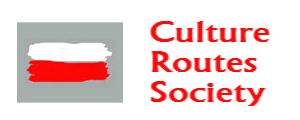
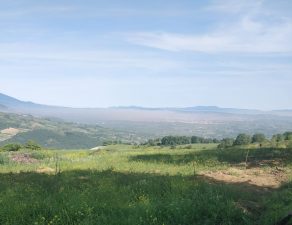
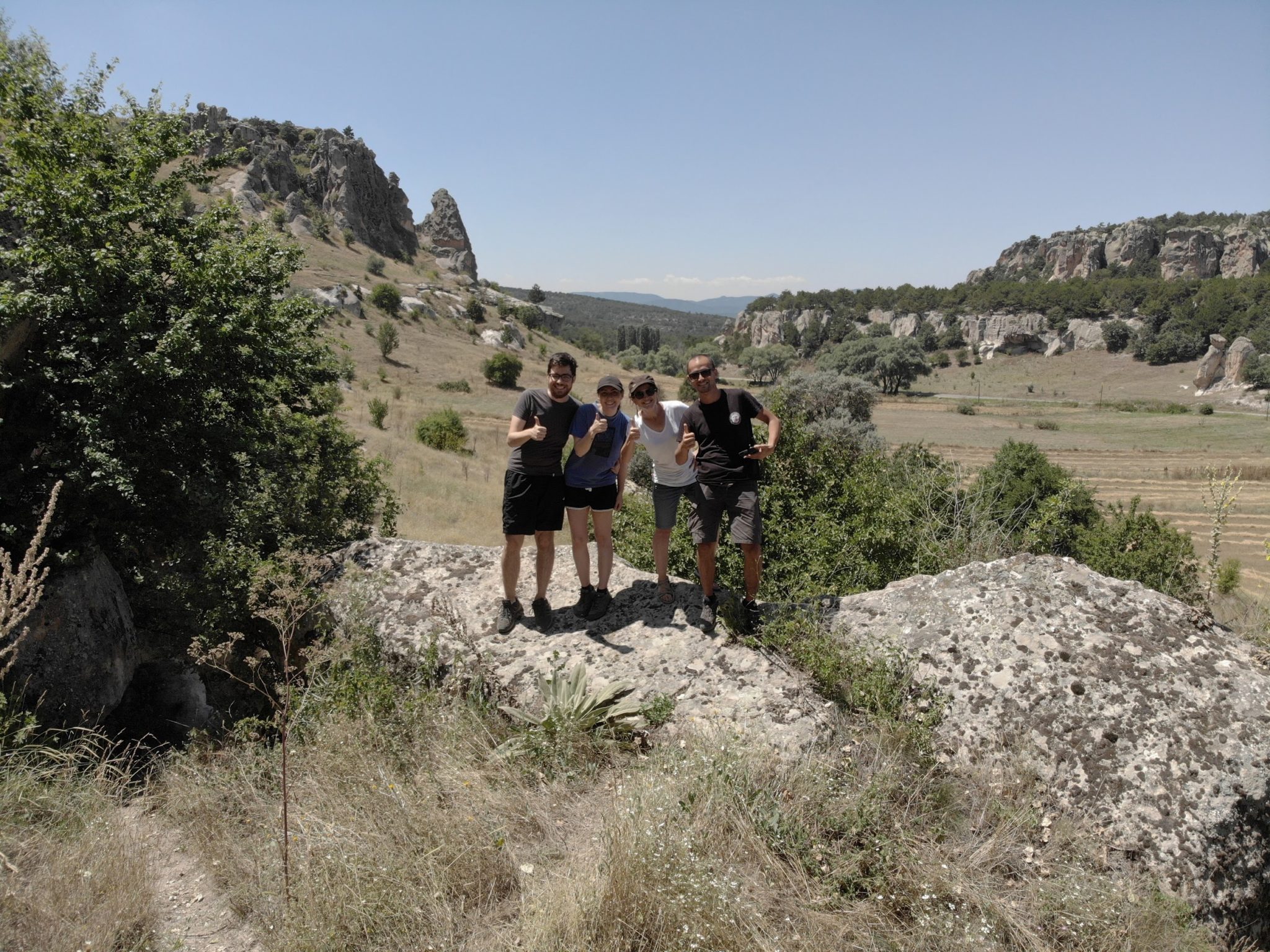
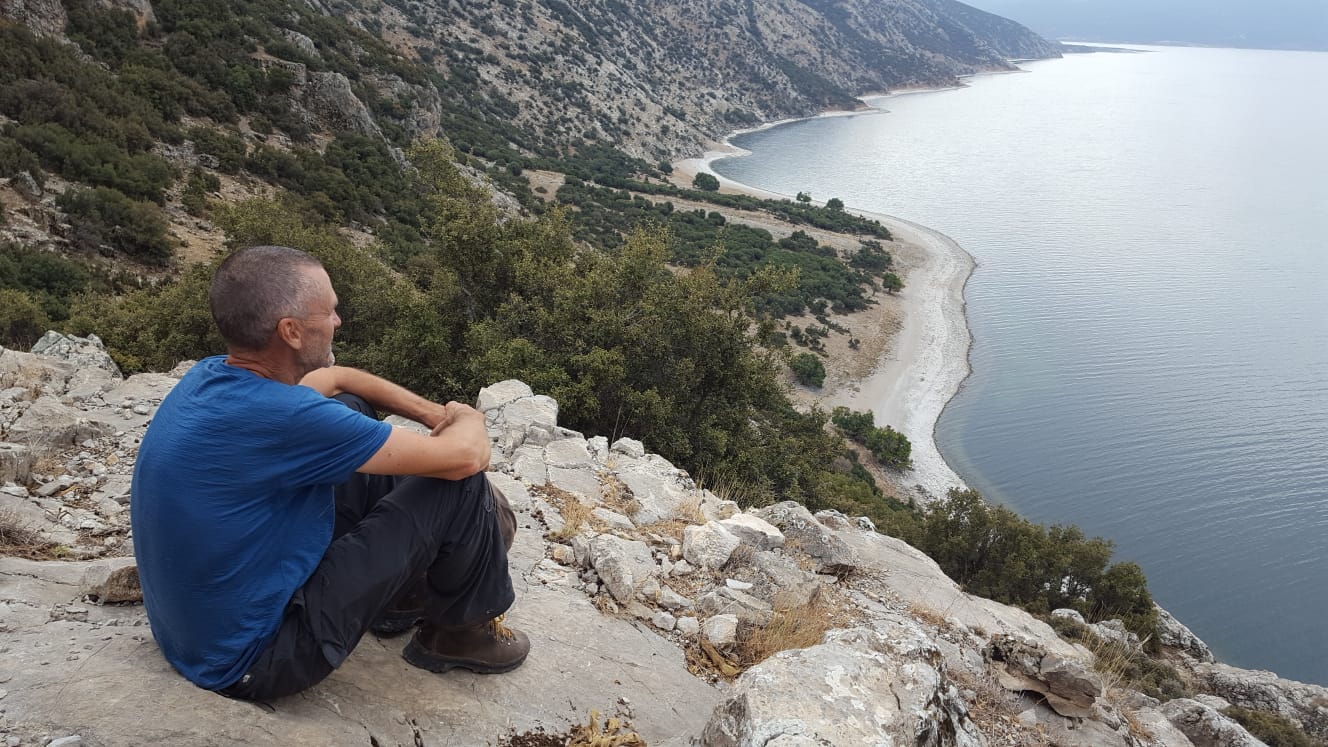
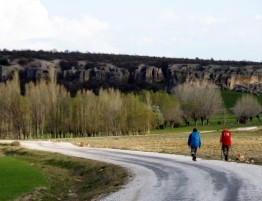
1 Comment
cuioreowg
June 20, 2023
يجب أن تؤخذ طرق التخلص من النمل في الاعتبار يجب أن يتم تنظيف المنزل باستمرار ، وقبل كل شيء من الضروري التخلص من القمامة وفتات الطعام ، فهي السبب الرئيسي لجذب النمل ، وهناك عدة طرق للتخلص منها. القرفة من التوابل المضادة للنمل ، ورائحتها كريهة للنمل ، لذا فهي تقيد وصولهم إلى المنزل. هذا لأنه يحتوي على مجموعة من الزيوت الطيارة. الخل الأبيض الخل الأبيض له رائحة كريهة للنمل ، بالإضافة إلى أنه يفقد الاتجاه والتركيز ، ويستخدم على النحو التالي: اخلطي أجزاء متساوية من الماء والخل الأبيض ، ضع المحلول الناتج في زجاجة رذاذ ، مع إضافة بضع قطرات من الزيت العطري ، رج الزجاجة جيدا ورش المحلول على عش النمل ، كرر هذه العملية مرة واحدة يوميا. البوراكسبوراكس مادة جذابة وسامة للنمل ، تساهم في تدميرها ، وتستخدم على النحو التالي: خلط كميات متساوية من البوراكس وبقايا الطعام وانتشارها على طبق مسطح في الأماكن التي يوجد بها الكثير من النمل. اخلطي البوراكس مع كمية قليلة من السكر وكمية قليلة من الماء لعمل عجينة ، ووزعيها في الأماكن التي ينتشر فيها النمل. اخلطي كميات متساوية من البورق ودقيق الذرة وبضع قطرات من الماء لعمل عجينة ، وضعيها في الأماكن التي يظهر فيها النمل.
https://janatmamlaka.wordpress.com/
Write a comment: